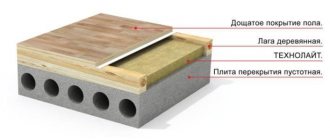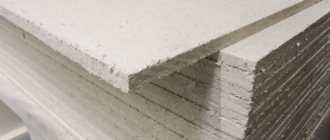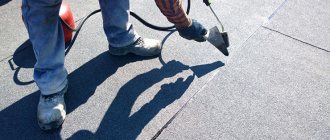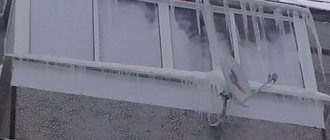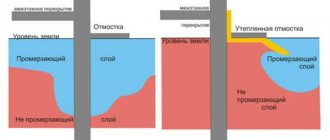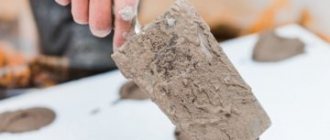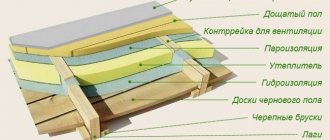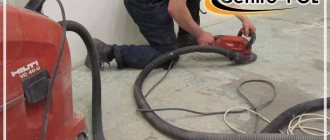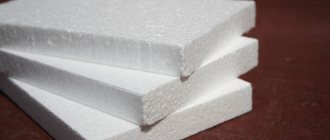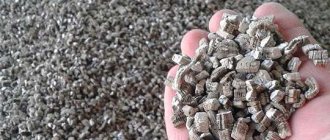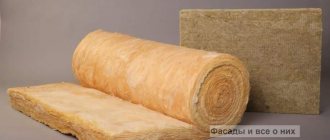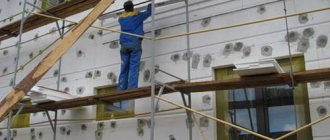Do I need to insulate the floor in the garage?
During the winter months, the air temperature in the garage, even with additional heating sources, tends to constantly drop. There are quite a few reasons for cooling - from insufficient wall thickness to incomplete sealing of doors. According to experts, about 20% of heat loss comes from cold floors.
Important! According to SNiP 02/21/99, the optimal temperature in the garage in winter should be about 5 degrees.
When connecting heating to a room, care must be taken to maintain it. Insulating a concrete floor will significantly reduce the level of heat loss. It is important to maintain an optimal temperature in the garage. Heat above 15 degrees in winter contributes to the formation of condensation under the bottom of the car, which has a destructive effect on the chassis.
Features of garage insulation
It is easier and more convenient to insulate garage premises during construction. Minimum thermal insulation should be included in the construction plan. If the garage has already been in use, and you decide to start insulating it in a few years, then this will be somewhat more difficult to do.
1. Material selection
Considering that there is now a fairly wide selection of materials on the market not only for construction, but also for insulation, it can be extremely difficult to settle on just one. Especially if you have not previously had experience in thermal insulation of premises.
2. Difficulties at work
This is not to say that insulating a garage is a difficult or overwhelming task. But it may not be so easy for a beginner in this business. If you decide to carry out all the work yourself, you should be prepared for unforeseen situations and difficulties. But don’t be afraid, with careful and attentive planning, detailed study of the issue and accuracy, you will be able to avoid pitfalls and the task will be completely doable.
3. Temperature
The issue of temperature conditions in the garage is quite controversial. Since there is no single standard for storing a car. But there are several points that must be taken into account. If the garage is used exclusively as a place to store a car, it does not need to be heated. Well-thought-out insulation will be enough to ensure that the temperature in winter does not drop below 0°C. The optimal temperature is +5°C. Why is temperature above this mark not recommended? The answer is simple - due to strong changes. If your garage warms up to 15-20°C, and the temperature outside is below zero, this will lead to condensation. And high humidity in the room contributes to the appearance of rust on body parts, which will negatively affect the overall condition of the car.
4. Cost.
At first glance, it may seem that insulating a garage is not expensive. But even if the least expensive materials are used, the price will be quite high. Therefore, it is worth calculating the funds, and it is better to buy all the necessary materials at once, so that the work does not freeze in the middle.
These are just the main points that you need to know and remember if you are planning to insulate your garage. Therefore, consider your strengths and capabilities before you start work.
How to insulate a garage floor
There are many ways to improve the thermal insulation of a garage floor. The simplest method is to lay a wooden floor. In this case, the concrete base is lined with a board 3-4 cm thick, fitting the logs tightly to each other. This method is guaranteed to increase the temperature in the room. In addition, this design makes it easy to dismantle damaged areas of the floor.
You can insulate the floor using specialized insulation materials. Modern manufacturers offer a wide selection of different materials, noticeably different from each other not only in price and appearance, but also in their characteristics. Such insulation is divided into 2 types:
- Foamed. These include polystyrene foam, penoplex, polyurethane foam. Most often, this material is produced in the form of slabs or panels. It does not allow moisture to pass through and ensures tightness during insulation. Such materials require sufficient ventilation to prevent condensation from accumulating in the room.
- Mineral. This type includes basalt wool and glass wool. Traditionally produced in the form of rolls or square slabs. Pairs best with wood floors. Need additional waterproofing.
High-quality insulation is the key to maintaining optimal temperature in the garage
There are other ways to insulate garage floors. You can use sand, crushed stone, expanded clay or roofing felt. Whatever the material, it is important to remember about additional insulation from moisture and possible fire. The insulation should not contain elements that can harm human health.
Frame for insulation
For any heat-insulating material on top of a concrete coating, you will definitely need to install a frame, otherwise the insulating elements will move in different directions.
- Below we will look at how to insulate a garage floor with your own hands using a wooden frame.
- The entire perimeter of the room is covered with wooden beams.
- The transverse and longitudinal ribs of the lattice are laid.
- The cells are formed depending on the size of the heat-insulating material.
- Gaps and joints to the wooden base are filled with polyurethane foam.
- A waterproofing coating is laid on top of the wooden mesh.
How to insulate a garage floor with your own hands
Every owner wants the garage to be dry and warm. Before you begin repairing and insulating the floor, you need to clearly identify the most important points for yourself. The most important factor includes the general condition of the garage, namely how long it has been in use and whether dismantling of the old floor covering is necessary.
Depending on the desired timing and financial capabilities, a floor insulation plan is drawn up. If desired, you can either pour a new concrete screed, insulating it with foam materials, or lay wooden logs and cover them with a new floor covering. Depending on the method chosen, the materials used may vary significantly.
How to insulate a wood floor in a garage
The most common method of insulation is the use of mineral wool. The material is inexpensive, and installation is quite simple even for beginners. To insulate the floor in this way, you need to:
- level the soil and pour a 5-10 cm layer of sand on it;
- pour concrete screed;
- lay waterproofing from roofing material or polyethylene;
- install wooden logs so that the distance between them is equal to the width of the thermal insulation roll;
- place mineral wool in the recesses;
- cover the insulation with a layer of waterproofing;
- install wooden covering.
Wooden logs can be installed on a base made of crushed stone or expanded clay
In addition to mineral wool, you can also use regular polystyrene foam or expanded polystyrene. Such materials are best suited if the garage already has an uninsulated concrete floor. In this case, polystyrene foam is placed in the space between the wooden supports. Its thickness should be at least 10 cm. Waterproofing is laid on top of it, after which a wooden floor is installed on top.
How to insulate a concrete floor in a garage
The use of a solid base is suitable for owners of large, heavy machines. Despite the advantages of wooden floors, concrete screed guarantees the safety of the coating over a long period of use. In addition, if such a base is cracked or has insufficient thermal insulation, you can always lay a new layer on top of the old one.
The easiest way to insulate a concrete floor in a garage is to use expanded clay. To do this, a layer of bulk material 25-30 cm thick is poured onto the leveled soil. Afterwards, a reinforced mesh is placed on it and a concrete screed is poured.
Important! To prevent a thick layer of expanded clay from reducing the height of the ceilings, before work it is necessary to dig a pit of 40-50 cm.
An alternative to using expanded clay is to insulate the garage floor with penoplex. This material will ensure minimal heat loss. To do this, a layer of waterproofing is placed on the old screed. It is covered with penoplex, covered with a metal mesh on top and a concrete screed is poured.
Penoplex is ideal for floor insulation
If you need to install additional heating, you can use a heated floor system. To do this, when insulating a concrete floor in a garage with polystyrene foam, it is necessary to lay special heating pipes. In this case, lay a layer of reflective film on the insulation with the shiny side up. A mesh and polypropylene tubes are placed on it. A concrete screed 8-10 cm thick is poured over the structure.
Sand and crushed stone
Insulation of the floor in the garage should begin with a loose cushion of crushed stone and sand. This combination of elements will be an excellent basis for any interior covering. Start work by compacting the soil in a depression of about 30 cm. You need to fill the crushed stone with a 10 cm cushion, and sand on top of it. The resulting gasket must be allowed to settle for some time so that the sand fills all empty cavities without the formation of gaps.
The next step will be covering the crushed stone cushion with a concrete screed. The correct solution in terms of waterproofing would be to pour a hot bitumen solution over the sand. In this case, the screed is poured from above and reinforced with an iron mesh. A solution of fine river sand with a small proportion of cement mixed with water is evenly applied on top of the concrete. The final coating must be carried out no earlier than a week later; the bottom layer must be allowed to dry thoroughly. Crushed stone and sand will provide not only thermal insulation, but also the solidity of the structure.
Useful tips
To insulate your garage floors as efficiently as possible, there are some important details you need to pay attention to. Very often, garage cooperatives build premises equipped with inspection pits. In this case, it is not enough to simply insulate the floor; you must also take care of an open source of cold.
The inspection hole is rarely used for its intended purpose. To minimize heat loss, garage owners make plugs and insulate them with available materials. If the thermal insulation of the floor and the pit is different, there is a high probability of additional condensation in places where there is a temperature difference.
Important! The thickness of the insulation of the inspection hole plug must be the same as the thickness of the material used in the concrete screed.
If there is a basement in the garage, it is imperative to additionally insulate the partition between it and the main room. In order not to reduce the height of the ceilings, you can insulate the partition from the bottom side. Sheets of expanded polystyrene or other insulation are attached to the basement ceiling and secured with boards or metal profiles.
Choosing the right material
Most insulating materials are made from industrial waste. For this use:
- Cellulose;
- Glass;
- Various chemicals.
The less the insulation costs, the more shortcomings you can find in it . There is a large list of common materials. When choosing among them the one that is suitable for your conditions, you need to take into account both their positive properties and disadvantages.
Mineral wool
Among the many options for mineral wool, it is better to choose basalt
This material has been used for several decades. There are several varieties of mineral wool, the best of which is considered basalt. It perfectly protects against noise and retains heat, without impairing air circulation in the garage.
The material is produced in the form of soft, semi-rigid and hard mats. The last option is the most preferable. Rigid slabs are easy to install and have high performance qualities. Hard mineral wool will not slide off the surface of the walls, unlike soft ones.
No special tools are needed to work with mineral wool, which is why many garage owners choose this material for insulation.
Please note! Even the slightest moisture is unacceptable for mineral wool - the raw material does not retain heat well. When calculating the cost of thermal insulation of a garage, you need to add the cost of effective hydro- and vapor barrier materials.
Glass wool
Apart from being cheap, glass wool has no particular advantages.
This is one of the cheapest insulating materials, and this is its only advantage. It is necessary to work with glass wool only using protective equipment, since when it comes into contact with the eyes or skin, its particles cause redness, severe itching and even microtrauma.
Glass wool must be reliably protected from moisture, since when wet it loses its heat-insulating properties and crumples. In addition, there is an unpleasant odor in the room where it is used.
Styrofoam
Polystyrene foam is durable and easy to handle, but does not allow air to pass through well
Foam plastic is often used for internal insulation of a garage. This is a cheap and durable thermal insulation material that can protect your garage for several decades. Foam plastic is not afraid of fungus and insects, it does not rot at all, and besides, it is easy to cut. You can attach it without helpers, it weighs little and is easy to use.
But foam plastic also has disadvantages. Insulation almost does not allow air to pass through, so in the room where it is used, it is necessary to create a good ventilation system, and the areas where individual sheets are joined must be reliably sealed, otherwise condensation will begin to accumulate. Many chemicals will not harm it, but direct rays of the sun can destroy it. In addition, mice can live in foam plastic - without special protective measures, rodents can destroy it in just a couple of years of service.
Polyurethane foam
Polyurethane foam is highly valued by garage owners due to its resistance to the external environment. After application, it expands, eliminating all voids and cracks, and reliably adheres to the wall material, so condensation cannot collect under it. When polyurethane foam hardens, a dense hydrophobic layer is formed. The material does not burn and can last more than 50 years.
But, like any other materials, this heat insulator has its drawbacks. The most important of them is the difficulty of applying the material. Installation of polyurethane foam can only be done with the help of special equipment, and it is best to have specialists do it.
Reflective Thermal Insulation
Reflective insulation allows heat to be directed indoors
The advantage of foil insulation is that heat is reflected inside the room. The thickness of the reflective layer can reach up to 50 mm. Such materials significantly reduce heat loss in the garage, because they occur as a result of losses of infrared radiation. But they are not able to influence induction and convection losses of thermal energy, and this is a serious disadvantage.
Warm plaster
If your garage walls are made of brick or cinder block, you can use insulating plaster to insulate it. During its manufacture, the composition includes special additives that retain heat: vermicult, processed sawdust or polystyrene foam.
This insulation has good thermal insulation properties, but for such insulation to be effective, it is necessary to apply a thick layer of material to the surface of the walls, which will increase the load on the garage structure.
Recommendation! It is advisable to use warm plaster as additional insulation together with other insulation materials.
Warming paint
This material is made in the form of liquid polymers to which synthetic components are added. The resulting coating retains heat well. A 1mm thick layer of warm paint retains heat in the same way as a 50mm thick layer of mineral wool. When it completely hardens, a dense layer is created.
The coating does not interfere with air circulation and at the same time protects the surface from water penetration. Thermal insulating paint can be used for finishing metal and wooden surfaces. In addition, it is good because it is very easy to apply to walls.
